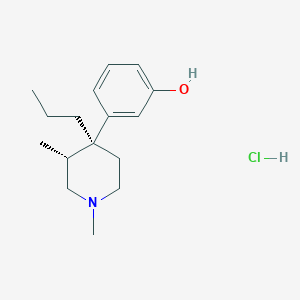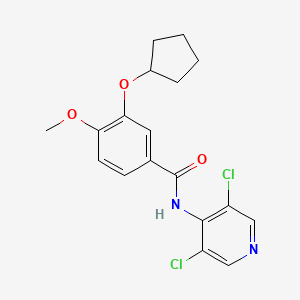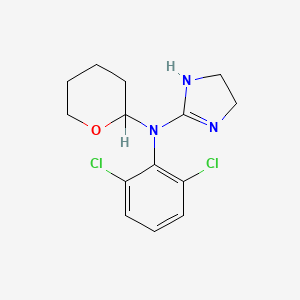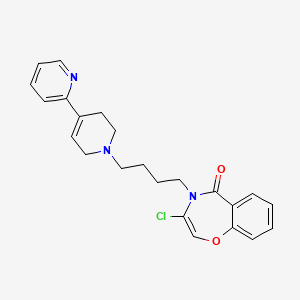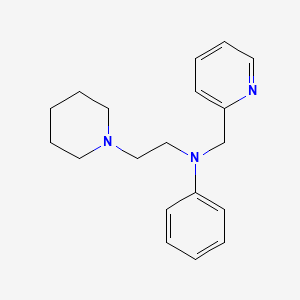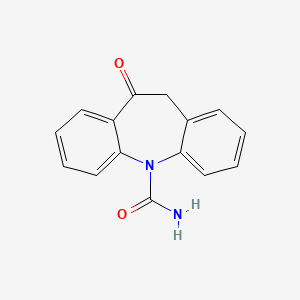
オクスカルバゼピン
概要
説明
オクスカルバゼピンは、主にてんかんの治療に使用される薬剤です。カルバマゼピンの構造誘導体であり、抗てんかん作用が知られています。オクスカルバゼピンは、トリレプタルやオクセラールXRなど、さまざまなブランド名で販売されています。 成人および小児の両方における部分発作の管理に使用されます .
2. 製法
合成経路と反応条件: オクスカルバゼピンは、カルバマゼピン分子を酸化させる化学反応によってカルバマゼピンから合成されます。このプロセスは通常、過酸化水素や過酸などの酸化剤の使用を伴います。 反応条件には、カルバマゼピンをオクスカルバゼピンに選択的に酸化するため、制御された温度とpHが含まれます .
工業的生産方法: 工業的な設定では、オクスカルバゼピンの生産は、同様の酸化剤を用いた大規模酸化反応を伴います。 このプロセスは、高収率と純度のために最適化されており、多くの場合、再結晶やクロマトグラフィーなどの複数の精製工程が含まれ、不純物や副生成物を除去します .
作用機序
オクスカルバゼピンとその活性代謝物であるMHDは、電位依存性ナトリウムチャネルを遮断することで作用を及ぼします。この作用は、過度に興奮した神経膜を安定させ、神経細胞の反復的な発火を抑制し、シナプスインパルスの伝播を減少させます。 これらのメカニズムは、発作の伝播を防ぐために重要です .
類似化合物:
カルバマゼピン: オクスカルバゼピンが由来する母体化合物。
エスリカルバゼピン: 同様の抗てんかん作用を持つ別の誘導体。
ラモトリギン: 化学構造は異なるものの、同様の治療用途を持つ抗てんかん薬 .
比較:
オクスカルバゼピン対カルバマゼピン: オクスカルバゼピンは、カルバマゼピンと比較して、副作用プロファイルが良好で、薬物相互作用が少ないです.
オクスカルバゼピン対エスリカルバゼピン: 両方とも作用機序は似ていますが、エスリカルバゼピンはプロドラッグとして市販されており、薬物動態が改善されている可能性があります.
オクスカルバゼピン対ラモトリギン: 両方ともてんかんの治療に使用されますが、ラモトリギンは躁うつ病にも使用され、グルタミン酸の放出阻害という異なる作用機序を持っています.
オクスカルバゼピンは、薬物相互作用の起こりやすさが低く、副作用プロファイルが比較的良好で、部分発作の管理に効果的であるため、際立っています .
科学的研究の応用
Oxcarbazepine has a wide range of applications in scientific research:
Chemistry: Used as a model compound to study oxidation and reduction reactions.
Biology: Investigated for its effects on neuronal activity and neurotransmitter release.
Medicine: Extensively studied for its anticonvulsant properties and potential use in treating bipolar disorder.
Industry: Used in the development of new pharmaceutical formulations and drug delivery systems .
生化学分析
Biochemical Properties
Oxcarbazepine exerts its effects by interacting with various biomolecules in the body. The primary biochemical property of oxcarbazepine is its ability to inhibit voltage-gated sodium channels, which are essential for the propagation of action potentials in neurons. By blocking these channels, oxcarbazepine reduces the abnormal electrical activity in the brain that leads to seizures . Additionally, oxcarbazepine undergoes rapid and extensive metabolism to its active metabolite, 10-hydroxycarbazepine, through the action of cytosolic arylketone reductase .
Cellular Effects
Oxcarbazepine has significant effects on various types of cells and cellular processes. In neurons, oxcarbazepine inhibits the excessive firing of action potentials by blocking voltage-gated sodium channels. This action stabilizes hyperexcited neural membranes and reduces the frequency of seizures . Oxcarbazepine also influences cell signaling pathways, gene expression, and cellular metabolism. It has been shown to modulate the release of neurotransmitters, thereby affecting synaptic transmission and neuronal communication .
Molecular Mechanism
The molecular mechanism of oxcarbazepine involves its interaction with voltage-gated sodium channels. By binding to these channels, oxcarbazepine prevents the influx of sodium ions, which is necessary for the initiation and propagation of action potentials in neurons . This blockade of sodium channels reduces neuronal excitability and prevents the spread of abnormal electrical activity in the brain. Additionally, oxcarbazepine’s active metabolite, 10-hydroxycarbazepine, contributes to its anticonvulsant effects by further inhibiting sodium channels .
Temporal Effects in Laboratory Settings
In laboratory settings, the effects of oxcarbazepine have been studied over time to understand its stability, degradation, and long-term impact on cellular function. Oxcarbazepine is rapidly absorbed and metabolized to 10-hydroxycarbazepine, which has a longer half-life and provides sustained anticonvulsant effects . Studies have shown that oxcarbazepine maintains its efficacy over extended periods, with minimal degradation . Long-term treatment with oxcarbazepine has been associated with stable seizure control and minimal adverse effects on cellular function .
Dosage Effects in Animal Models
The effects of oxcarbazepine vary with different dosages in animal models. At therapeutic doses, oxcarbazepine effectively reduces seizure frequency without causing significant adverse effects . At higher doses, oxcarbazepine can lead to toxic effects, including sedation, ataxia, and hepatotoxicity . Animal studies have also shown that chronic administration of oxcarbazepine can result in the development of tolerance, necessitating dose adjustments to maintain its anticonvulsant efficacy .
Metabolic Pathways
Oxcarbazepine is primarily metabolized in the liver through the action of cytosolic arylketone reductase, which converts it to its active metabolite, 10-hydroxycarbazepine . This metabolite is further metabolized through glucuronidation and hydroxylation pathways . The metabolic pathways of oxcarbazepine are distinct from those of carbamazepine, resulting in reduced drug-drug interactions and a more favorable safety profile .
Transport and Distribution
After oral administration, oxcarbazepine is rapidly absorbed and distributed throughout the body . Its active metabolite, 10-hydroxycarbazepine, has a volume of distribution of 0.75 L/kg and is extensively bound to plasma proteins . Oxcarbazepine and its metabolites are primarily excreted through the kidneys . The transport and distribution of oxcarbazepine within cells and tissues are influenced by its interactions with transporters and binding proteins .
Subcellular Localization
Oxcarbazepine and its active metabolite, 10-hydroxycarbazepine, are localized within the cytosol of cells . The subcellular localization of oxcarbazepine is crucial for its activity, as it allows the compound to interact with voltage-gated sodium channels and exert its anticonvulsant effects . The targeting of oxcarbazepine to specific cellular compartments is facilitated by its chemical structure and post-translational modifications .
準備方法
Synthetic Routes and Reaction Conditions: Oxcarbazepine is synthesized from carbamazepine through a chemical reaction that involves the oxidation of the carbamazepine molecule. The process typically involves the use of oxidizing agents such as hydrogen peroxide or peracids. The reaction conditions include controlled temperature and pH to ensure the selective oxidation of the carbamazepine to oxcarbazepine .
Industrial Production Methods: In industrial settings, the production of oxcarbazepine involves large-scale oxidation reactions using similar oxidizing agents. The process is optimized for high yield and purity, often involving multiple purification steps such as recrystallization and chromatography to remove impurities and by-products .
化学反応の分析
反応の種類: オクスカルバゼピンは、次のようなさまざまな化学反応を起こします。
酸化: オクスカルバゼピンからその活性代謝物である10,11-ジヒドロ-10-ヒドロキシカルバマゼピン(MHD)への変換。
還元: 還元反応は、オクスカルバゼピンをその前駆体形式に戻すことができます。
一般的な試薬と条件:
酸化剤: 過酸化水素、過酸。
還元剤: 水素化ホウ素ナトリウム、水素化リチウムアルミニウム。
置換試薬: ハロゲン、アルキル化剤
主要な生成物:
10,11-ジヒドロ-10-ヒドロキシカルバマゼピン(MHD): 主な活性代謝物。
さまざまな置換誘導体: 置換反応で使用される試薬に応じて
4. 科学研究への応用
オクスカルバゼピンは、科学研究において幅広い用途があります。
化学: 酸化反応と還元反応を研究するためのモデル化合物として使用されます。
生物学: 神経活動と神経伝達物質放出への影響について調査されています。
医学: 抗てんかん作用と、躁うつ病の治療における潜在的な使用について広く研究されています。
類似化合物との比較
Carbamazepine: The parent compound from which oxcarbazepine is derived.
Eslicarbazepine: Another derivative with similar anticonvulsant properties.
Lamotrigine: An anticonvulsant with a different chemical structure but similar therapeutic uses .
Comparison:
Oxcarbazepine vs. Carbamazepine: Oxcarbazepine has a better side effect profile and fewer drug interactions compared to carbamazepine.
Oxcarbazepine vs. Eslicarbazepine: Both have similar mechanisms of action, but eslicarbazepine is marketed as a prodrug with potentially improved pharmacokinetics.
Oxcarbazepine vs. Lamotrigine: While both are used to treat epilepsy, lamotrigine is also used for bipolar disorder and has a different mechanism of action involving the inhibition of glutamate release.
Oxcarbazepine stands out due to its reduced propensity for drug-drug interactions and its effectiveness in managing partial-onset seizures with a relatively favorable side effect profile .
特性
IUPAC Name |
5-oxo-6H-benzo[b][1]benzazepine-11-carboxamide | |
|---|---|---|
| Source | PubChem | |
| URL | https://pubchem.ncbi.nlm.nih.gov | |
| Description | Data deposited in or computed by PubChem | |
InChI |
InChI=1S/C15H12N2O2/c16-15(19)17-12-7-3-1-5-10(12)9-14(18)11-6-2-4-8-13(11)17/h1-8H,9H2,(H2,16,19) | |
| Source | PubChem | |
| URL | https://pubchem.ncbi.nlm.nih.gov | |
| Description | Data deposited in or computed by PubChem | |
InChI Key |
CTRLABGOLIVAIY-UHFFFAOYSA-N | |
| Source | PubChem | |
| URL | https://pubchem.ncbi.nlm.nih.gov | |
| Description | Data deposited in or computed by PubChem | |
Canonical SMILES |
C1C2=CC=CC=C2N(C3=CC=CC=C3C1=O)C(=O)N | |
| Source | PubChem | |
| URL | https://pubchem.ncbi.nlm.nih.gov | |
| Description | Data deposited in or computed by PubChem | |
Molecular Formula |
C15H12N2O2 | |
| Source | PubChem | |
| URL | https://pubchem.ncbi.nlm.nih.gov | |
| Description | Data deposited in or computed by PubChem | |
DSSTOX Substance ID |
DTXSID0045703 | |
| Record name | Oxcarbazepine | |
| Source | EPA DSSTox | |
| URL | https://comptox.epa.gov/dashboard/DTXSID0045703 | |
| Description | DSSTox provides a high quality public chemistry resource for supporting improved predictive toxicology. | |
Molecular Weight |
252.27 g/mol | |
| Source | PubChem | |
| URL | https://pubchem.ncbi.nlm.nih.gov | |
| Description | Data deposited in or computed by PubChem | |
Physical Description |
Solid | |
| Record name | Oxcarbazepine | |
| Source | Human Metabolome Database (HMDB) | |
| URL | http://www.hmdb.ca/metabolites/HMDB0014914 | |
| Description | The Human Metabolome Database (HMDB) is a freely available electronic database containing detailed information about small molecule metabolites found in the human body. | |
| Explanation | HMDB is offered to the public as a freely available resource. Use and re-distribution of the data, in whole or in part, for commercial purposes requires explicit permission of the authors and explicit acknowledgment of the source material (HMDB) and the original publication (see the HMDB citing page). We ask that users who download significant portions of the database cite the HMDB paper in any resulting publications. | |
Solubility |
Slightly soluble in chloroform, dichloromethane, acetone, and methanol and practically insoluble in ethanol, ether, and water., 1.60e-01 g/L | |
| Record name | OXCARBAZEPINE | |
| Source | Hazardous Substances Data Bank (HSDB) | |
| URL | https://pubchem.ncbi.nlm.nih.gov/source/hsdb/7524 | |
| Description | The Hazardous Substances Data Bank (HSDB) is a toxicology database that focuses on the toxicology of potentially hazardous chemicals. It provides information on human exposure, industrial hygiene, emergency handling procedures, environmental fate, regulatory requirements, nanomaterials, and related areas. The information in HSDB has been assessed by a Scientific Review Panel. | |
| Record name | Oxcarbazepine | |
| Source | Human Metabolome Database (HMDB) | |
| URL | http://www.hmdb.ca/metabolites/HMDB0014914 | |
| Description | The Human Metabolome Database (HMDB) is a freely available electronic database containing detailed information about small molecule metabolites found in the human body. | |
| Explanation | HMDB is offered to the public as a freely available resource. Use and re-distribution of the data, in whole or in part, for commercial purposes requires explicit permission of the authors and explicit acknowledgment of the source material (HMDB) and the original publication (see the HMDB citing page). We ask that users who download significant portions of the database cite the HMDB paper in any resulting publications. | |
Mechanism of Action |
The exact mechanism through which oxcarbazepine and its active metaoblite, MHD, exert their anti-epileptic effects is unclear, but is thought to primarily involve the blockade of voltage-gated sodium channels. The opening and closing of sodium channels allows for the propagation of action potentials along neurons - in epilepsy, these action potentials can occur in excess of that required for normal function, and the repetitive and pathological firing of these action potentials leads to seizure activity. Both oxcarbazepine and MHD are thought to inhibit seizure activity by binding to the inactive state of voltage-gated sodium channels, thus prolonging the period in which the receptor is unavailable for action potential propagation. This helps to stabilize hyperexcited neuronal membranes, inhibit repetitive neuron firing, and prevent the spread of seizure activity within the CNS without affecting normal neuronal transmission. Increased potassium conductance and modulation of voltage-activated calcium channels is also thought to play a role in the anti-seizure activity of oxcarbazepine. Inhibition of glutamatergic activity was thought to contribute to oxcarbazepine's activity, but this effect could not be replicated _in vivo_., The pharmacological activity of Trileptal (oxcarbazepine) is primarily exerted through the 10-monohydroxy metabolite (MHD) of oxcarbazepine. The precise mechanism by which oxcarbazepine and MHD exert their antiseizure effect is unknown; however, in vitro electrophysiological studies indicate that they produce blockade of voltage-sensitive sodium channels, resulting in stabilization of hyperexcited neural membranes, inhibition of repetitive neuronal firing, and diminution of propagation of synaptic impulses. These actions are thought to be important in the prevention of seizure spread in the intact brain. In addition, increased potassium conductance and modulation of high-voltage activated calcium channels may contribute to the anticonvulsant effects of the drug. No significant interactions of oxcarbazepine or MHD with brain neurotransmitter or modulator receptor sites have been demonstrated. | |
| Record name | Oxcarbazepine | |
| Source | DrugBank | |
| URL | https://www.drugbank.ca/drugs/DB00776 | |
| Description | The DrugBank database is a unique bioinformatics and cheminformatics resource that combines detailed drug (i.e. chemical, pharmacological and pharmaceutical) data with comprehensive drug target (i.e. sequence, structure, and pathway) information. | |
| Explanation | Creative Common's Attribution-NonCommercial 4.0 International License (http://creativecommons.org/licenses/by-nc/4.0/legalcode) | |
| Record name | OXCARBAZEPINE | |
| Source | Hazardous Substances Data Bank (HSDB) | |
| URL | https://pubchem.ncbi.nlm.nih.gov/source/hsdb/7524 | |
| Description | The Hazardous Substances Data Bank (HSDB) is a toxicology database that focuses on the toxicology of potentially hazardous chemicals. It provides information on human exposure, industrial hygiene, emergency handling procedures, environmental fate, regulatory requirements, nanomaterials, and related areas. The information in HSDB has been assessed by a Scientific Review Panel. | |
Color/Form |
Crystals from ethanol, White to faintly orange crystalline powder | |
CAS No. |
28721-07-5 | |
| Record name | Oxcarbazepine | |
| Source | CAS Common Chemistry | |
| URL | https://commonchemistry.cas.org/detail?cas_rn=28721-07-5 | |
| Description | CAS Common Chemistry is an open community resource for accessing chemical information. Nearly 500,000 chemical substances from CAS REGISTRY cover areas of community interest, including common and frequently regulated chemicals, and those relevant to high school and undergraduate chemistry classes. This chemical information, curated by our expert scientists, is provided in alignment with our mission as a division of the American Chemical Society. | |
| Explanation | The data from CAS Common Chemistry is provided under a CC-BY-NC 4.0 license, unless otherwise stated. | |
| Record name | Oxcarbazepine [USAN:USP:INN:BAN] | |
| Source | ChemIDplus | |
| URL | https://pubchem.ncbi.nlm.nih.gov/substance/?source=chemidplus&sourceid=0028721075 | |
| Description | ChemIDplus is a free, web search system that provides access to the structure and nomenclature authority files used for the identification of chemical substances cited in National Library of Medicine (NLM) databases, including the TOXNET system. | |
| Record name | Oxcarbazepine | |
| Source | DrugBank | |
| URL | https://www.drugbank.ca/drugs/DB00776 | |
| Description | The DrugBank database is a unique bioinformatics and cheminformatics resource that combines detailed drug (i.e. chemical, pharmacological and pharmaceutical) data with comprehensive drug target (i.e. sequence, structure, and pathway) information. | |
| Explanation | Creative Common's Attribution-NonCommercial 4.0 International License (http://creativecommons.org/licenses/by-nc/4.0/legalcode) | |
| Record name | OXCARBAZEPINE | |
| Source | DTP/NCI | |
| URL | https://dtp.cancer.gov/dtpstandard/servlet/dwindex?searchtype=NSC&outputformat=html&searchlist=758693 | |
| Description | The NCI Development Therapeutics Program (DTP) provides services and resources to the academic and private-sector research communities worldwide to facilitate the discovery and development of new cancer therapeutic agents. | |
| Explanation | Unless otherwise indicated, all text within NCI products is free of copyright and may be reused without our permission. Credit the National Cancer Institute as the source. | |
| Record name | Oxcarbazepine | |
| Source | EPA DSSTox | |
| URL | https://comptox.epa.gov/dashboard/DTXSID0045703 | |
| Description | DSSTox provides a high quality public chemistry resource for supporting improved predictive toxicology. | |
| Record name | Oxcarbazepine | |
| Source | European Chemicals Agency (ECHA) | |
| URL | https://echa.europa.eu/substance-information/-/substanceinfo/100.044.702 | |
| Description | The European Chemicals Agency (ECHA) is an agency of the European Union which is the driving force among regulatory authorities in implementing the EU's groundbreaking chemicals legislation for the benefit of human health and the environment as well as for innovation and competitiveness. | |
| Explanation | Use of the information, documents and data from the ECHA website is subject to the terms and conditions of this Legal Notice, and subject to other binding limitations provided for under applicable law, the information, documents and data made available on the ECHA website may be reproduced, distributed and/or used, totally or in part, for non-commercial purposes provided that ECHA is acknowledged as the source: "Source: European Chemicals Agency, http://echa.europa.eu/". Such acknowledgement must be included in each copy of the material. ECHA permits and encourages organisations and individuals to create links to the ECHA website under the following cumulative conditions: Links can only be made to webpages that provide a link to the Legal Notice page. | |
| Record name | OXCARBAZEPINE | |
| Source | FDA Global Substance Registration System (GSRS) | |
| URL | https://gsrs.ncats.nih.gov/ginas/app/beta/substances/VZI5B1W380 | |
| Description | The FDA Global Substance Registration System (GSRS) enables the efficient and accurate exchange of information on what substances are in regulated products. Instead of relying on names, which vary across regulatory domains, countries, and regions, the GSRS knowledge base makes it possible for substances to be defined by standardized, scientific descriptions. | |
| Explanation | Unless otherwise noted, the contents of the FDA website (www.fda.gov), both text and graphics, are not copyrighted. They are in the public domain and may be republished, reprinted and otherwise used freely by anyone without the need to obtain permission from FDA. Credit to the U.S. Food and Drug Administration as the source is appreciated but not required. | |
| Record name | OXCARBAZEPINE | |
| Source | Hazardous Substances Data Bank (HSDB) | |
| URL | https://pubchem.ncbi.nlm.nih.gov/source/hsdb/7524 | |
| Description | The Hazardous Substances Data Bank (HSDB) is a toxicology database that focuses on the toxicology of potentially hazardous chemicals. It provides information on human exposure, industrial hygiene, emergency handling procedures, environmental fate, regulatory requirements, nanomaterials, and related areas. The information in HSDB has been assessed by a Scientific Review Panel. | |
| Record name | Oxcarbazepine | |
| Source | Human Metabolome Database (HMDB) | |
| URL | http://www.hmdb.ca/metabolites/HMDB0014914 | |
| Description | The Human Metabolome Database (HMDB) is a freely available electronic database containing detailed information about small molecule metabolites found in the human body. | |
| Explanation | HMDB is offered to the public as a freely available resource. Use and re-distribution of the data, in whole or in part, for commercial purposes requires explicit permission of the authors and explicit acknowledgment of the source material (HMDB) and the original publication (see the HMDB citing page). We ask that users who download significant portions of the database cite the HMDB paper in any resulting publications. | |
Melting Point |
215-216 °C, 215.5 °C | |
| Record name | OXCARBAZEPINE | |
| Source | Hazardous Substances Data Bank (HSDB) | |
| URL | https://pubchem.ncbi.nlm.nih.gov/source/hsdb/7524 | |
| Description | The Hazardous Substances Data Bank (HSDB) is a toxicology database that focuses on the toxicology of potentially hazardous chemicals. It provides information on human exposure, industrial hygiene, emergency handling procedures, environmental fate, regulatory requirements, nanomaterials, and related areas. The information in HSDB has been assessed by a Scientific Review Panel. | |
| Record name | Oxcarbazepine | |
| Source | Human Metabolome Database (HMDB) | |
| URL | http://www.hmdb.ca/metabolites/HMDB0014914 | |
| Description | The Human Metabolome Database (HMDB) is a freely available electronic database containing detailed information about small molecule metabolites found in the human body. | |
| Explanation | HMDB is offered to the public as a freely available resource. Use and re-distribution of the data, in whole or in part, for commercial purposes requires explicit permission of the authors and explicit acknowledgment of the source material (HMDB) and the original publication (see the HMDB citing page). We ask that users who download significant portions of the database cite the HMDB paper in any resulting publications. | |
Synthesis routes and methods I
Procedure details








Synthesis routes and methods II
Procedure details







Synthesis routes and methods III
Procedure details





Synthesis routes and methods IV
Procedure details





Synthesis routes and methods V
Procedure details





Retrosynthesis Analysis
AI-Powered Synthesis Planning: Our tool employs the Template_relevance Pistachio, Template_relevance Bkms_metabolic, Template_relevance Pistachio_ringbreaker, Template_relevance Reaxys, Template_relevance Reaxys_biocatalysis model, leveraging a vast database of chemical reactions to predict feasible synthetic routes.
One-Step Synthesis Focus: Specifically designed for one-step synthesis, it provides concise and direct routes for your target compounds, streamlining the synthesis process.
Accurate Predictions: Utilizing the extensive PISTACHIO, BKMS_METABOLIC, PISTACHIO_RINGBREAKER, REAXYS, REAXYS_BIOCATALYSIS database, our tool offers high-accuracy predictions, reflecting the latest in chemical research and data.
Strategy Settings
| Precursor scoring | Relevance Heuristic |
|---|---|
| Min. plausibility | 0.01 |
| Model | Template_relevance |
| Template Set | Pistachio/Bkms_metabolic/Pistachio_ringbreaker/Reaxys/Reaxys_biocatalysis |
| Top-N result to add to graph | 6 |
Feasible Synthetic Routes
試験管内研究製品の免責事項と情報
BenchChemで提示されるすべての記事および製品情報は、情報提供を目的としています。BenchChemで購入可能な製品は、生体外研究のために特別に設計されています。生体外研究は、ラテン語の "in glass" に由来し、生物体の外で行われる実験を指します。これらの製品は医薬品または薬として分類されておらず、FDAから任何の医療状態、病気、または疾患の予防、治療、または治癒のために承認されていません。これらの製品を人間または動物に体内に導入する形態は、法律により厳格に禁止されています。これらのガイドラインに従うことは、研究と実験において法的および倫理的な基準の遵守を確実にするために重要です。
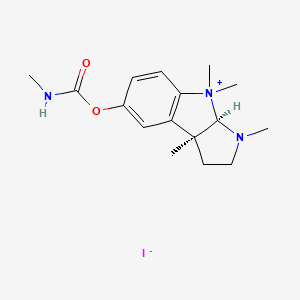
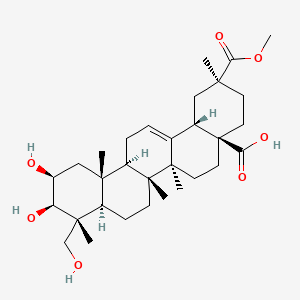
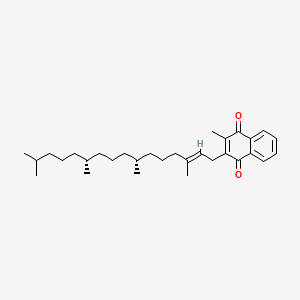
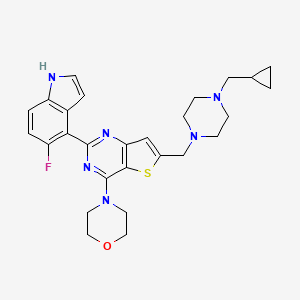
![2-hydroxyethyl 2-hydroxybenzoate-(4as,6as,11br,13bs)-4,4,6a,9-tetramethyl-1,2,3,4,4a,5,6,6a,11b,13b-decahydrobenzo[a]furo[2,3,4-mn]xanthen-11-ol(1:1)](/img/structure/B1677775.png)
![2-(4-(Methylamino)phenyl)benzo[d]thiazol-6-ol](/img/structure/B1677777.png)


